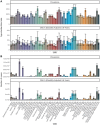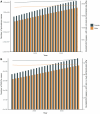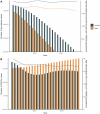Global trends in refractive disorders from 1990 to 2021: insights from the global burden of disease study and predictive modeling
- PMID: 40206172
- PMCID: PMC11978637
- DOI: 10.3389/fpubh.2025.1449607
Global trends in refractive disorders from 1990 to 2021: insights from the global burden of disease study and predictive modeling
Abstract
Purpose: This study aims to provide global, regional, and national estimates of the refractive disorders-related burden between 1990 and 2021, stratified by subtypes.
Design: A retrospective analysis was conducted using aggregated data.
Methods: Utilizing data from the Global Burden of Diseases, Injuries, and Risk Factors Study 2021 (GBD 2021), this population-based study analyzed the burden of refractive disorders from 1990 to 2021. Estimated annual percentage changes (EAPCs) were calculated to quantify temporal trends in age-standardized rates of refractive disorder prevalence and disability-adjusted life-years (DALYs), stratified by age, sex, region, and country. The associations between EAPCs in age-standardized rates and socio-demographic index (SDI) were also examined. Using comprehensive data, we conducted predictive analyses with the Age-Period-Cohort (APC) and Autoregressive Integrated Moving Average (ARIMA) models to forecast disease prevalence and Disability-Adjusted Life Years (DALYs) for informing future public health strategies.
Results: Globally, the age-standardized rates of refractive disorders per 100,000 population decreased in all age groups from 1990 to 2021. Specifically, prevalence rates declined from 2,053.56 (95% uncertainty interval [UI]: 1,835.31-2,275.8) to 1919.66 (95% UI: 1,715.24-2,135.28, EAPC: -0.24), while DALYs reduced from 88.04 (95% UI: 62.19-125.15) to 79.11 (95% UI: 54.94-114.14, EAPC: -0.36). These reductions were primarily driven by a decline in refractive disorders. Notably, both the prevalence and DALYs associated with refractive disorders decreased significantly in the 60 to 64 age group. In low and low-middle SDI countries, there was a significant reduction in both prevalence and DALYs, while high and middle-high SDI countries experienced an increase in these metrics. Benin exhibited the largest increase in prevalence and burden, while India had the most significant decrease. There are notable discrepancies between countries and regions compared to GBD estimates, indicating potential underestimations of refractive disorder prevalence and burden. The APC model details age-specific trends and cohort effects, while the ARIMA model offers strong predictions from historical data. Both models underscore fluctuating disease burdens, stressing the importance of adaptive health policies to meet future healthcare needs.
Conclusion: Over the past three decades, global efforts have significantly alleviated the burden of refractive errors. However, substantial disparities persist across different types of impairment, age groups, and countries' Socio-Demographic Index (SDI). With the conclusion of the COVID-19 pandemic, it is crucial to expand eye care services, particularly in enhancing screening coverage and quality control. This study underscores the importance of addressing diverse population needs and fostering regional cooperation to improve eye health outcomes, providing a comprehensive strategy for future public health initiatives.
Keywords: age-related; disability-adjusted life years; global burden of disease study; prevalence; refraction disorder.
Copyright © 2025 Huang, Zhang and Liu.
Conflict of interest statement
The authors declare that the research was conducted in the absence of any commercial or financial relationships that could be construed as a potential conflict of interest.
Figures












Similar articles
-
Global, regional, and national burden of refraction disorders: findings from the global burden of disease study 2021 and projections to 2050.BMC Public Health. 2025 Apr 2;25(1):1247. doi: 10.1186/s12889-025-22440-w. BMC Public Health. 2025. PMID: 40175971 Free PMC article.
-
Global incidence, prevalence, years lived with disability (YLDs), disability-adjusted life-years (DALYs), and healthy life expectancy (HALE) for 371 diseases and injuries in 204 countries and territories and 811 subnational locations, 1990-2021: a systematic analysis for the Global Burden of Disease Study 2021.Lancet. 2024 May 18;403(10440):2133-2161. doi: 10.1016/S0140-6736(24)00757-8. Epub 2024 Apr 17. Lancet. 2024. PMID: 38642570 Free PMC article.
-
Global burden of low vision and blindness due to age-related macular degeneration from 1990 to 2021 and projections for 2050.BMC Public Health. 2024 Dec 18;24(1):3510. doi: 10.1186/s12889-024-21047-x. BMC Public Health. 2024. PMID: 39695517 Free PMC article.
-
Global burden of motor neuron disease: unraveling socioeconomic disparities, aging dynamics, and divergent future trajectories (1990-2040).J Neurol. 2025 May 11;272(6):390. doi: 10.1007/s00415-025-13130-z. J Neurol. 2025. PMID: 40349275 Free PMC article. Review.
-
Global, regional, and national burden of asthma and atopic dermatitis, 1990-2021, and projections to 2050: a systematic analysis of the Global Burden of Disease Study 2021.Lancet Respir Med. 2025 May;13(5):425-446. doi: 10.1016/S2213-2600(25)00003-7. Epub 2025 Mar 24. Lancet Respir Med. 2025. PMID: 40147466
Cited by
-
Worldwide trends and future projections of fungal skin disease burden: a comprehensive analysis from the Global Burden of Diseases study 2021.Front Public Health. 2025 Jun 4;13:1580221. doi: 10.3389/fpubh.2025.1580221. eCollection 2025. Front Public Health. 2025. PMID: 40535451 Free PMC article.
References
MeSH terms
LinkOut - more resources
Full Text Sources
Medical
Miscellaneous

